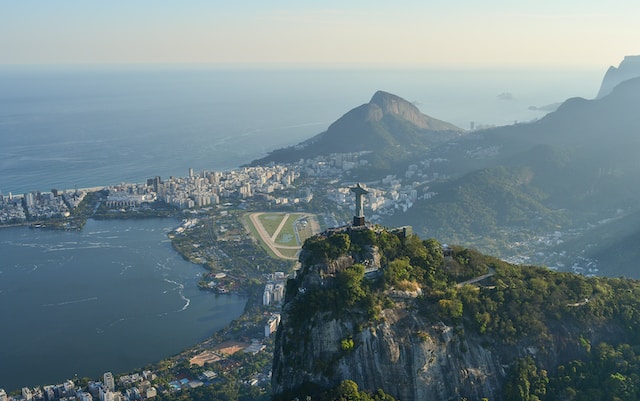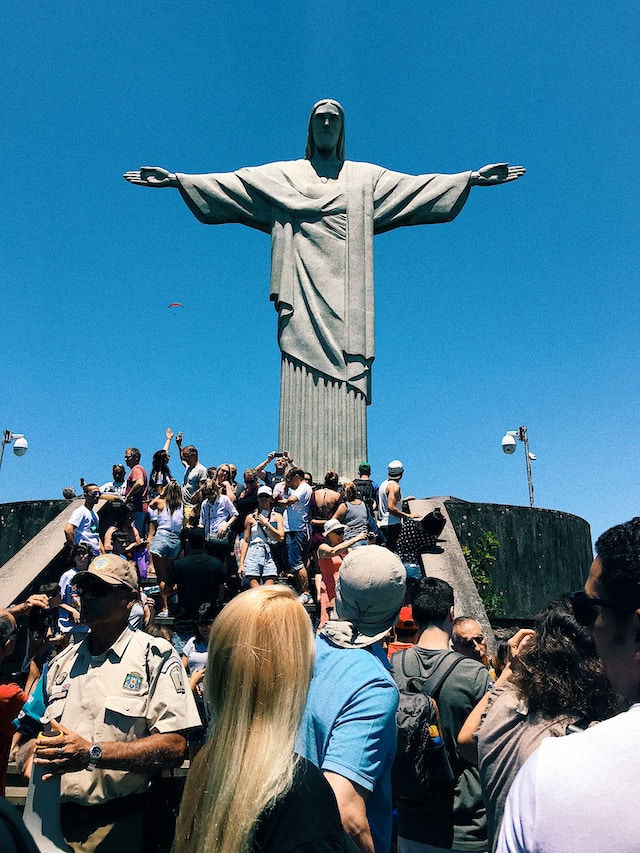I arrived at Christ the Redeemer at 8am on a Tuesday morning and had the viewing platform almost to myself. The statue emerged from lingering mist as I climbed the final steps, and for a few minutes I stood there alone with one of the world’s most recognisable landmarks. By 10am, tour groups had filled the space. Timing matters here.
Christ the Redeemer stands on Corcovado mountain, arms stretched wide over Rio de Janeiro. At 30 metres tall (38 metres including the pedestal), it’s smaller than you might expect from photographs – but its position 710 metres above sea level makes it visible from almost anywhere in the city.
The statue was completed in 1931, designed by Brazilian engineer Heitor da Silva Costa and sculpted by French-Polish artist Paul Landowski. The outer layer is made of soapstone tiles, which have held up remarkably well against Rio’s tropical weather. In 2007, it was voted one of the New Seven Wonders of the World.
Getting There
You have three main options for reaching the statue:
Corcovado Train
The most popular choice. The red cog train departs from Cosme Velho station and takes about 20 minutes to climb through the Tijuca Forest. Trains run every 30 minutes from 8am to 7pm. Book tickets in advance online – the queue for walk-ups can stretch for hours, especially on weekends.
The train journey itself is worth the trip. The track winds through dense Atlantic rainforest, and you’ll often spot monkeys and toucans from the windows.
Cost: Around R$100-150 (approximately £15-22) depending on time slot. Tickets include the train and entry to the statue platform.
Official Vans
Vans depart from Largo do Machado, Copacabana (Praça do Lido), and the Paineiras visitor centre. This is often faster than the train, particularly if you start from Paineiras – but you miss the scenic railway experience.
Cost: R$75-100 including entry.
Hiking
A trail leads from Parque Lage through the rainforest to the statue – about 3km with a steep climb. Allow 2-3 hours for the hike. You’ll still need to pay the entry fee when you arrive at the top. Only attempt this in dry weather and bring plenty of water.
Best Time to Visit
Early morning (8-9am) offers the clearest skies and smallest crowds. Rio often gets hazy by midday, reducing visibility.
Sunset is spectacular but busy. The city lights below and the statue illuminated above create memorable photos, but expect crowds.
Avoid weekends and Brazilian holidays if possible. The platform at the top isn’t large, and when it’s packed with tour groups, you’ll spend more time queuing than enjoying the view.
Weather matters. Clouds frequently wrap around Corcovado, and when they do, you can’t see anything. Check the webcam on the official site before heading up. If it’s cloudy, postpone – there’s no refund if you arrive and find yourself in a white fog.
May to October (Brazilian winter) typically has clearer skies and lower humidity than the summer months.
What to Expect at the Top
The viewing platform wraps around the base of the statue. On a clear day, you can see Sugarloaf Mountain, Copacabana and Ipanema beaches, the Maracanã Stadium, and the sprawling favelas climbing the hillsides.
The platform has a small chapel (Capela Nossa Senhora Aparecida) built into the base, a gift shop, and basic toilets. There’s no restaurant at the statue itself – eat before you go or wait until you’re back down.
Most visitors spend 30-45 minutes at the top. There’s a limit to how many photos you can take of the same view, and the platform gets crowded quickly.
Practical Tips
Bring sunscreen and water. There’s minimal shade on the platform and the sun reflects off the concrete.
Wear comfortable shoes. There are stairs to climb regardless of how you arrive.
Watch your belongings. Petty theft happens at tourist sites. Keep cameras secured and bags zipped.
Skip the selfie sticks. Everyone has the same idea, and you’ll spend more time dodging other people’s poles than taking photos.
The escalator and panoramic lift from the train platform to the statue base help with accessibility, but there are still some steps involved. Contact the site in advance if you have mobility concerns.
What’s Nearby
The statue is inside Tijuca National Park, one of the world’s largest urban forests. If you take the train, you won’t see much of it, but drivers and hikers pass through properly.
Parque Lage at the base of Corcovado has a beautiful colonial mansion (now an art school) with a café in the courtyard. It’s free to enter and makes a good stop before or after your visit.
Santa Teresa is a bohemian neighbourhood nearby with cobbled streets, street art, and small restaurants. Take a taxi or the historic tram (bonde) from the city centre.
Is It Worth It?
Yes – but manage your expectations. The statue itself is impressive, and the views of Rio are genuinely spectacular. However, it’s also expensive by Brazilian standards, crowded, and requires planning to visit properly.
If you’re in Rio, you should go. But book ahead, check the weather, and go early. A clear morning with few crowds beats a foggy weekend afternoon every time.
Frequently Asked Questions
How much does it cost to visit Christ the Redeemer?
The Corcovado train costs around R$100-150 (approximately £15-22) and includes the train journey and entry to the statue platform. Official vans cost R$75-100 including entry. Hiking is free but you still need to pay the entry fee when you arrive at the top.
How do I get to Christ the Redeemer?
You have three options: the Corcovado Train from Cosme Velho station (20 minutes through rainforest, most popular), official vans from Largo do Machado, Copacabana, or Paineiras, or hiking a 3km trail from Parque Lage (2-3 hours, steep climb). Book train tickets in advance online to avoid long queues.
What is the best time to visit Christ the Redeemer?
Early morning (8-9am) offers the clearest skies and smallest crowds. Rio often gets hazy by midday, reducing visibility. Avoid weekends and Brazilian holidays if possible. May to October (Brazilian winter) typically has clearer skies than summer months. Check the webcam on the official site before going.
Can you see Christ the Redeemer in cloudy weather?
Clouds frequently wrap around Corcovado mountain, and when they do you can’t see anything. There’s no refund if you arrive and find yourself in fog. Check the live webcam on the official website before heading up and postpone if it’s cloudy.
How long should I spend at Christ the Redeemer?
Most visitors spend 30-45 minutes at the top. The viewing platform wraps around the base of the statue with views of Sugarloaf Mountain, Copacabana and Ipanema beaches, Maracana Stadium, and the favelas. There’s a small chapel, gift shop, and basic toilets at the base.
Is Christ the Redeemer accessible for people with mobility issues?
There’s an escalator and panoramic lift from the train platform to the statue base, which helps with accessibility. However, there are still some steps involved. Contact the site in advance if you have specific mobility concerns to plan your visit properly.
















